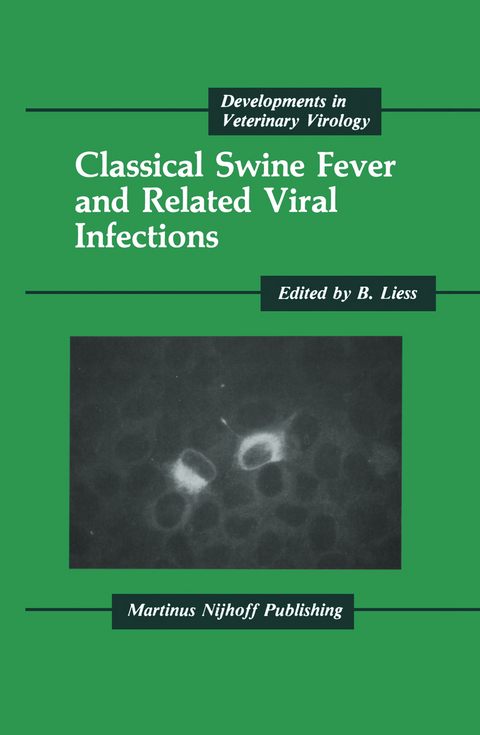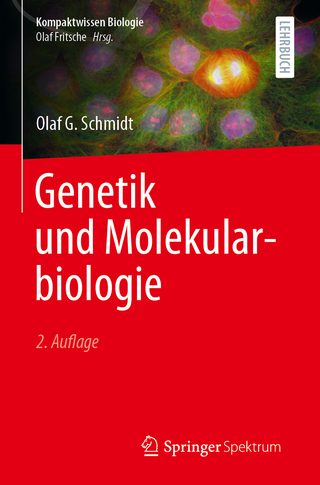
Classical Swine Fever and Related Viral Infections
Kluwer Academic Publishers (Verlag)
978-0-89838-969-2 (ISBN)
1. Description of the virus infection.- 1. Introduction.- 2. Viral and host determinants of virulence.- 3. Infections with high-virulent virus strains.- 4. Infections with moderate-virulent virus strains.- 5. Infections with low-virulent virus strains.- 6. Infections with avirulent virus strains.- 7. Concluding remarks.- 2. Pathology and pathogenesis of the disease.- 1. Introduction.- 2. Pathology of classical swine fever.- 3. Light and electron microscopical changes.- 4. Haematological findings.- 5. Blood coagulation disorders.- 6. Foetal and neonatal pathology.- 7. Congenital persistent HC virus infection.- 8. Pathogenesis of HC virus infection.- 9. Concluding remarks.- 3. Characteristics of the virus.- 1. Virion morphology.- 2. Physico-chemical properties.- 3. Isolation and cultivation.- 4. Viral strains.- 5. Serological relationship to other pestiviruses.- 4. Molecular biology of the virus.- 1. Introduction.- 2. Taxonomy.- 3. Molecular biology of the togaviruses.- 4. Ribonucleic acid of pestiviruses.- 5. Structural proteins of pestiviruses.- 6. Replication, strain differences and mutants of pestiviruses.- 7. Conclusions.- 5. Diagnostic procedures.- 1. Introduction.- 2. Laboratory diagnosis.- 3. Characteristics of isolates from field outbreaks.- 4. Concluding remarks.- 6. Serology.- 1. Introduction.- 2. Serologic reactions used for humoral antibody detection.- 3. Application of serological methods.- 4. Concluding remarks.- 7. Immunological aspects of the infection.- 1. Introduction.- 2. Humoral immune response.- 3. Cellular immune response.- 4. Effects of HCV infections on immune functions.- 5. Discussion and concluding remarks.- 8. Principles of vaccination.- 1. Introduction.- 2. Types of vaccines.- 3. Properties of modern live virus vaccines.- 4. Immunity induced by modern live virus vaccines.- 5. Use of modern live virus vaccines.- 6. Vaccination failures.- 7. Appraisal of vaccination: Epizootiological and economic impact.- 9. Vaccines.- 1. Introduction.- 2. Production of HCV vaccines.- 3. Properties of HCV vaccines.- 4. Conclusions.- 10. Epizootiology of hog cholera.- 1. Introduction.- 2. Distribution and economic impact.- 3. Transmission.- 4. Reservoirs.- 5. Factors influencing the epizootiology.- 6. Tracing of herds infected with HC.- 7. Concluding remarks.- 11. Control of classical swine fever.- 1. Introduction.- 2. The epidemiologic situation.- 3. The structure of the pig production.- 4. Public control of CSF.- 5. The legislation of the EEC on CSF.- 6. Legal measures against CSF in case of emergency situations.- 7. The EEC programme for eradication of CSF.- 8. The CSF epizootic in Belgium, the Netherlands and the Federal Republic of Germany.- 9. Concluding remarks.- 12. The comparative biology of classicle swine fever.- 1. Introduction.- 2. Prenatal infection.- 3. The legacy of intra-uterine infection.- 4. Acute postnatal infections.- 5. Epidemiology and control.
| Reihe/Serie | Developments in Veterinary Virology ; 5 |
|---|---|
| Zusatzinfo | XIV, 298 p. |
| Verlagsort | New York |
| Sprache | englisch |
| Maße | 155 x 235 mm |
| Themenwelt | Medizin / Pharmazie ► Medizinische Fachgebiete ► Mikrobiologie / Infektologie / Reisemedizin |
| Studium ► 2. Studienabschnitt (Klinik) ► Humangenetik | |
| Naturwissenschaften ► Biologie ► Mikrobiologie / Immunologie | |
| Naturwissenschaften ► Biologie ► Zoologie | |
| ISBN-10 | 0-89838-969-0 / 0898389690 |
| ISBN-13 | 978-0-89838-969-2 / 9780898389692 |
| Zustand | Neuware |
| Haben Sie eine Frage zum Produkt? |
aus dem Bereich


